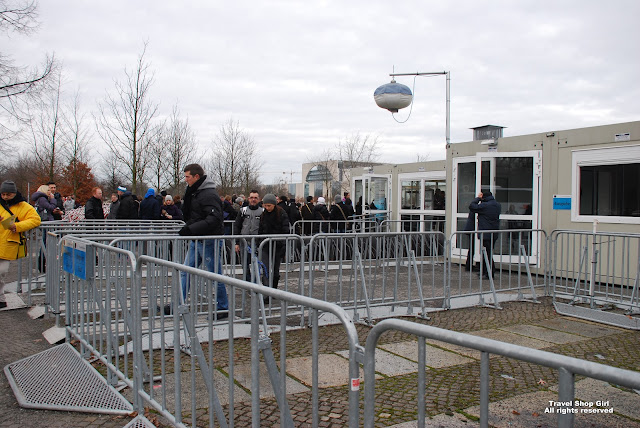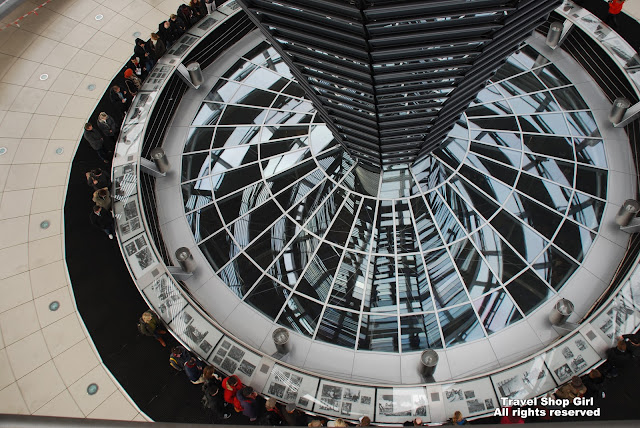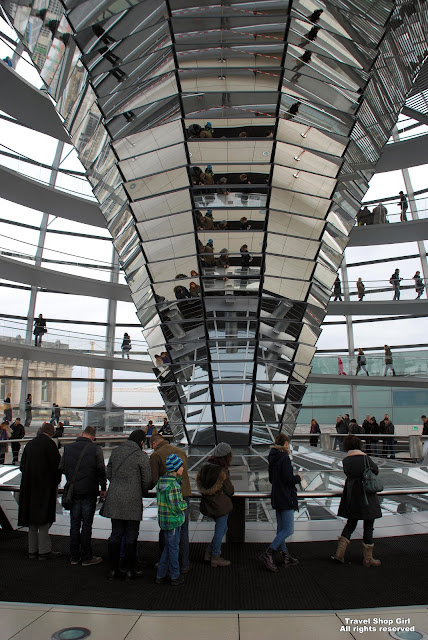 |
| The Reichstag |
Facing the cold weather, we persevered and headed directly to the Reichstag after walking past the Brandenburg Gate. It wasn’t snowing or even windy, but it was bone chilling cold out. I was so glad that I packed lightweight liners to wear under my clothes plus my gloves and scarf.
Why did we choose the Reichstag? With only a few days in Berlin, we did want to hit as many of the most memorable sites as we could and the Reichstag was definitely on our list since we could do it in a day.
What exactly is the Reichstag? The Reichstag is the seat of the German Bundestag or federal government. After the founding of the German Empire in 1872, there was a need for a large parliamentary building in Berlin. The building was designed by Paul Wallot and constructed between 1884 and 1894, mainly funded with wartime reparation money from France, a result of Prussia’s defeat of France in 1871.
 |
| Tour bus anyone? |
Maybe you’re not up for walking to make your way over to the Reichstag, but don’t worry. This is clearly a big stop for any one of a number of sightseeing buses in Berlin.
 |
| Make sure you have your appointment before going inside |
As we approached the Reichstag, we could see the entrance as there were lines leading up to the entrance of the small trailers outside. In order to enter the Reichstag, it is necessary to register in advance on their website. Ilka had advised us that it was “really cool to go up into the glass cupola,” so we were excited to see what it had in store for us. Although our appointment was for 11:45 am, we arrived at 10:45 am and thought we might be able to just walk around beforehand. Did I mention that it is free to go inside? If you didn’t make an appointment, they will direct you across the street where you can use the internet to make your appointment.
 |
| Grilling is FORBIDDEN! |
One of the signs outside of the entrance was interesting enough for me to snap this picture. At first I thought it was my poor attempt at translation, but the picture sealed the deal. Grilling is forbidden here!
You enter the building and provide the registration form and your passport. We were an hour early and of course, I completely slipped up and forgot my passport, but they let me in anyway. Not sure if they should have done that or not, but they did. You are then escorted by groups to stand to the side to wait until you can enter.
 The front of the building bears the words, “Dem Deutschen Volke” which translates to “To the German People.” This famous inscription was added long after the construction of the Reichstag in 1916 by emperor Wilhelm II. The bronze letters were cast from seized French cannons.
The front of the building bears the words, “Dem Deutschen Volke” which translates to “To the German People.” This famous inscription was added long after the construction of the Reichstag in 1916 by emperor Wilhelm II. The bronze letters were cast from seized French cannons.
Do not miss the detail work all over the exterior of this building, but if you do while you are going into the building, take a minute on the way out to stop and appreciate the handiwork of the artisans who created it.
Hitler never used the Reichstag, but instead a former opera house opposite the Reichstag. Just four weeks after being sworn in as Chancellor, the Reichstag was on fire and the Nazis said this was evidence that the Communists were beginning a plot against the German government. In reality, it was later learned that the fire was started by the Nazis.
Some post-World War II information from Berlin.de:
The Reichstag building suffered heavy damage in bombing raids during World War II, and the fight to take the building continued until the very end. In 1955, the Bundestag decided to rebuild it, although without a dome, the original of which had been demolished in 1954 because it was structurally unsound. Renovation was carried out according to plans by Paul Baumgarten and not completed until 1972. The decorative figures that had been destroyed were not restored, and the façade was simplified. Despite the restrictions on use mandated by the Four-Power Agreement, parliamentary committees and groups met in the Reichstag building as often as possible. On 4 October 1990, the first parliament representing all of Germany and consisting of members of the Bundestag and former members of the GDR’s Volkskammer (People’s Chamber) met in the plenary chamber of the Reichstag building, followed two months later by the first sessions of the freely elected, all-German Bundestag beginning on 20 December 1990.
 |
| Inside the Dome |
Once you exit the trailers outside, from there you are ushered up the stairs and again into another area to wait. It’s all very James Bond-like as doors open in front of you and others close behind you. You are then squeezed into an elevator with everyone in your group (hope you aren’t claustrophobic!) and then the doors open after what seems like an insanely long amount of time. A desk is just outside of the elevator doors with free audio guides. These are available in ten languages: German, English, French, Spanish, Italian, Portuguese, Polish, Russian, Turkish, and Dutch. Stand in the line (we didn’t see it and got reprimanded!), but I can tell you that having one is well worth it as all of the sights are pointed out that you might otherwise miss.
 |
| View to the east from the Reichstag |
The views from inside are beyond incredible as you get a 360° view of the entire city.
Your brain will be on overload as you try to take in all of the views of the city, but also the building itself, which is a sculptural wonder. As you ascend to the top, you can peer out the opening and then begin your descent back down. Visitors inside the dome never cross paths as they go up and then down on separate levels and then exit unless they stop to go in the restaurant, Käfer, near the rooftop.
 |
| The dome was the creation of British architect Sir Norman Foster |
Once you reach the top, you can view the structure from the outside. British architect Sir Norman Foster was given the task of renovating the building. He needed to create “…a point of operation for a newly-restored democratic government, but make it publicly accessible and adhere to historical sensitivity and sustainable factors.” (From Holiday Velvet) The fact that a foreigner was chosen for the redesign of the country’s national parliament suggests an openness and a desire for transparency, which Foster was able to translate literally.
 The views from up on the roof aren’t too shabby either! At first I thought this was the ferris wheel from the now defunct Spreepark, but it’s not. It’s the Roue Parisienne ferris wheel which was originally in Paris in 2000 for the Millennium celebration, but is now in Berlin although I can’t seem to find out why. Perhaps for the New Year’s Eve celebrations?
The views from up on the roof aren’t too shabby either! At first I thought this was the ferris wheel from the now defunct Spreepark, but it’s not. It’s the Roue Parisienne ferris wheel which was originally in Paris in 2000 for the Millennium celebration, but is now in Berlin although I can’t seem to find out why. Perhaps for the New Year’s Eve celebrations?
 Here’s another great view. That large white roof is the Haus der Kulturen der Welt, Germany’s national center for contemporary non-European art. To the right is the Bundeskanzleramt or the German Chancellery which is a federal agency serving the executive office of the Chancellor, which is the head of the German federal government.
Here’s another great view. That large white roof is the Haus der Kulturen der Welt, Germany’s national center for contemporary non-European art. To the right is the Bundeskanzleramt or the German Chancellery which is a federal agency serving the executive office of the Chancellor, which is the head of the German federal government.
 Behind the white and black building you can see a portion of the 368 meter Fernsehturm (the television tower), which is a huge tourist attraction in Berlin. The Neue Synagoge (New Synagogue) built between 1859-1866 in a Moorish style with its highly recognizable blue dome can be seen on the right.
Behind the white and black building you can see a portion of the 368 meter Fernsehturm (the television tower), which is a huge tourist attraction in Berlin. The Neue Synagoge (New Synagogue) built between 1859-1866 in a Moorish style with its highly recognizable blue dome can be seen on the right.
 Here you can see the Quadriga of Victory atop the Brandenburg Gate and all of the preparations that were starting to get underway a few days in advance of the New Year’s Eve festivities.
Here you can see the Quadriga of Victory atop the Brandenburg Gate and all of the preparations that were starting to get underway a few days in advance of the New Year’s Eve festivities.
 One of my favorite vantage points, which doesn’t translate well into a picture is the view down into the actual Parliament building. The dome floods the main hall with natural light and as such, you can view the blue chairs of the Bundestag. If you’re lucky, which we weren’t, you could see them in session. With a reservation and a tour guide, you can actually take a tour inside. Here is some additional information about the reopening of the building from Berlin.de.
One of my favorite vantage points, which doesn’t translate well into a picture is the view down into the actual Parliament building. The dome floods the main hall with natural light and as such, you can view the blue chairs of the Bundestag. If you’re lucky, which we weren’t, you could see them in session. With a reservation and a tour guide, you can actually take a tour inside. Here is some additional information about the reopening of the building from Berlin.de.
The new Reichstag building was officially opened on 19 April 1999. The new dome, which visitors can enter, has proven to be an especially strong attraction and has become a symbol of the parliament and government district. Eight hundred tons of steel and 3,000 square meters of glass went into building this structure, which is 23.5 meters high, while 360 mirrors provide daylight to the newly designed plenary chamber. The parliament took up its work in Berlin at the end of the summer recess in 1999.
 Back down at the main level, there are photographs with historical information in German and English that you can view prior to leaving. Once you are ready to leave, queue up again and when there are enough people in line, they will pile everyone back up again inside the elevator to the main floor.
Back down at the main level, there are photographs with historical information in German and English that you can view prior to leaving. Once you are ready to leave, queue up again and when there are enough people in line, they will pile everyone back up again inside the elevator to the main floor.
 Since we didn’t stop for a bite to eat inside the restaurant, we opted instead for a pretzel from this guy with a pretzel cart. Pretty impressive, huh?
Since we didn’t stop for a bite to eat inside the restaurant, we opted instead for a pretzel from this guy with a pretzel cart. Pretty impressive, huh?
Next up? More Berlin, of course!







We saw that building when we were there, but didn’t make it in. I wish we had after seeing all your pictures. That’s a lot of pretzels!
I have to say that I am so incredibly glad we went. The views were amazing and learning about the history was so incredibly important. Just means you have to make a stop next time, right?
Happy memories from our trip to Berlin a few years ago. I don’t think you could pre-book then, so we queued for quite some time but it was worth it – a fabulous building.
It definitely made it less stressful to have the visit pre-booked so we didn’t have to wait to long in a line. It is an amazing place, isn’t it?
I’ve seen that building when i was there,